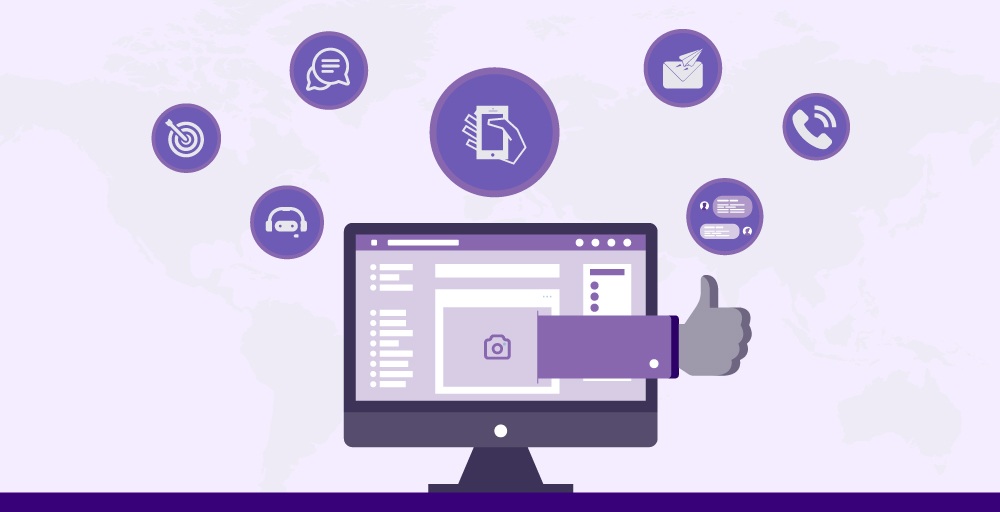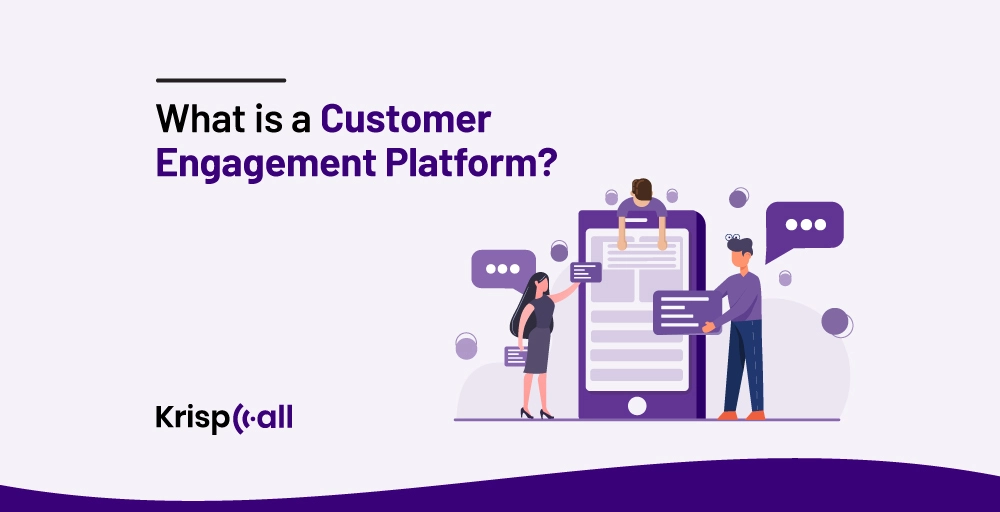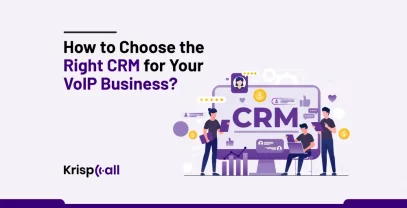Imagine having a central hub where you can manage all your conversations with customers, no matter how they choose to interact with you. That’s the power of a Customer Engagement Platform (CEP).
In today’s digital world, customers expect a seamless and personalized experience across every touchpoint, from social media to email to live chat. A CEP can help you deliver exactly that.
But what is a CEP? And how can this benefit your business?
In this blog, we’ll cover what a customer engagement platform is, including its definition, benefits, and how it enhances the overall customer experience.
Let’s dive in🌊
🔐IMPORTANT HIGHLIGHTS:-
- A customer engagement platform is a flexible software that allows businesses to provide trusted, smooth, and enhanced customer engagement.
- The Customer Engagement Platform ( CEP ) creates trusted customer relationships that boost brand loyalty and reputation while reducing costs.
- Key features of CEP include Omnichannel communications, Integrations, personalized functions, and AI features.
- Customer engagement platforms enhance the overall customer experience by helping with recommendations, answering questions quickly, and providing personalized solutions to customer problems.
What is a Customer Engagement Platform (CEP)?
A customer engagement platform (CEP) is software that enables businesses to interact, communicate, and build relationships with customers across multiple channels. It analyzes, manages, and optimizes customer problems and journeys. It also integrates various communication channels, such as email, social media, live chat, and SMS, into a single platform. Some examples of CEPs are Zendesk, HubSpot, Salesforce, and Intercom.

Some examples of what customer engagement platforms can do are:
- Send the customer a customized welcoming message after creating an account.
- Providing direct links for downloading apps on their mobile devices.
- Sending push notifications for important events to customer
- Whenever customers like an item, send them a notification regarding the item.
Why Customer Engagement Platforms are essential?
Customer Engagement Platforms (CEPs) are essential for businesses because they empower companies to cultivate stronger relationships with their customers. They provide a centralized solution for managing customer interactions across multiple channels, such as social media, email, and live chat.
Moreover, Customer Engagement Platforms (CEPs) bring together information about customers from different places. This helps businesses learn what each customer likes. Then, they can send personalized marketing messages, suggest products, and provide support that fits each customer better. This makes the experience more interesting and meaningful for customers.
Benefits of Customer Engagement Platforms
Some of the benefits of customer engagement platforms are:
1. Create a Trusted Customer Relationship
Businesses often focus more on sales, while they should prioritize the relationship with customers and their needs. A good customer management platform can help companies analyze their customers’ wants and work accordingly.
This helps with customer satisfaction and builds trust in the relationship with the company. With a trusty relationship, businesses can achieve high revenue and retention rates. If the customer gets enough attention, they start trusting the brand and stick to it.
2. Boost Brand Loyalty and Reputation
A lousy customer experience badly affects the company’s reputation and growth, and a customer engagement platform can provide the needed support, engagement, and connections with customers.
With CEP, companies can now responsibly collect and analyze customer data. This leads to a better-personalized customer experience and strong brand loyalty. It also eases the process of understanding customer needs and wants.
3. Reducing Cost while Increasing Value
A proper customer engagement platform allows businesses to target customers more effectively and understand their behaviors. This reduces churn and efficiently increases the rate of new customers.
A report from Twilio in 2022 showed that 60% of people can be repetitive buyers after a personalized experience. This increases the company’s revenue and adds value in the long term.
4. Provide Unique Customer Experience Anytime, Everywhere
Understanding how every customer interaction is going in every channel is essential for building a customer profile. By analyzing this and utilizing CPaaS technology, companies can have a list of customer engagement platforms when needed.
The integration of CPaaS with CEP makes it a more powerful customer data platform. Now, customers can choose how the business engages with them through multiple channels, including email and SMS.
What are the Key Features of Customer Engagement Platforms?
There are multiple customer engagement platforms in the market, and their features differentiate them from each other.
Key features that a customer engagement platform should contain are:
- Omnichannel communication: The customer engagement platform must support omnichannel communication, which allows users to use multiple channels, such as email, SMS, social media, and in-app messaging.
- Real-time analytics with reporting: Real-time analytics and reporting help monitor the performance and keep track of the datas. This helps businesses make decisions.
- Integrations: A better CEP should support integrations with multiple platforms, such as CRM software, social media platforms, project management tools, and CDP software. Integrations allow the platform to be used in various ways and with wide capabilities.
- Personalization functions: Personalization functions within a customer engagement platform allow businesses to tailor recommendations, communication, and advisory content to individual customers based on their preferences and behavior.
- AI features: The use of AI has increased rapidly, and AI features are crucial too in customer engagement platforms because they enhance automation and data analysis. AI features automate chatbots and enable predictive analytics. Eventually, this will improve efficiency, accuracy, and the overall customer experience.
Customer Engagement Platforms Vs CRM: What are the Differences?
Both CEPs (Customer Engagement Platforms) and CRM ( Customer Relationship Management) are used to improve the customer experience and help businesses better understand customer preferences.

Besides the similarities, a few differences between CEP and CRM are below:
| Customer Engagement Platform ( CEP ) | Customer Relationship Management ( CRM ) |
| CEPs are mainly designed for engagement to support growth at a rapid scale. | CRM is basically a system that records customer interaction. |
| Covers a broad range of customer engagement activities, including marketing, sales, and customer support. | Primarily focused on sales and customer service functions |
| CEPs focus on understanding customer behavior for personalized engagement. | CRMs centralize communications and analyze trends to smooth communications. |
| Build long-term relationships with customers and foster brand loyalty. | Improve sales processes and lead management. |
| Suitable for B2C, particularly retail, e-commerce, and direct sales | Primarily used in B2B scenarios. |
How does CEP Enhance the Overall Customer Experience?
Customer Engagement Platforms (CEPs) enhance the overall customer experience in two ways. First, CEPs collect info about what each customer likes from different touchpoints. This helps companies give recommendations, answer questions, and solve problems in a way that fits each customer. When companies pay attention to what customers want, it makes customers feel important and happy.
Secondly, customers expect to interact with brands on their preferred channels. CEPs provide a unified platform for managing communication across various channels, such as email, social media, and live chat. This makes it easy and consistent for customers to reach out to the company however they want.
Conclusion
Customer Engagement Platforms (CEPs) empower businesses to move beyond simply reacting to customer issues. They provide businesses with measurable data on customer engagement metrics, such as conversion rates, customer lifetime value, and churn rates.
This data allows companies to track progress, optimize strategies, and demonstrate the tangible ROI of their customer engagement efforts. Hence, with a good CEP, businesses can boost revenue and sales by creating solid relationships with new and existing customers.
FAQs
What do you mean by Customer Engagement?
Customer engagement means creating a relationship with a customer by a company to increase brand loyalty and provide value to its customer base.
Customer Engagement Platforms VS Customer Data Platforms: What are the differences?
Customer Engagement platforms utilize customer data to personalize interactions and drive engagement. They provide features for communication across various channels, content management, and campaign automation.
On the other hand, Customer Data Management specializes in collecting and unifying customer data from disparate sources to create a single customer view. They cleanse, organize, and analyze this data to provide insights into customer behavior.
What are Customer Engagement Models?
The customer engagement model is a strategy businesses use to engage prospects and customers at every step of the customer journey and respond effectively to their interactions. It helps increase customer satisfaction, retention, and Customer Lifetime Value (CLV).





